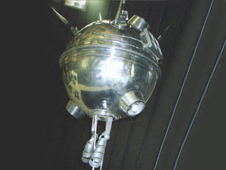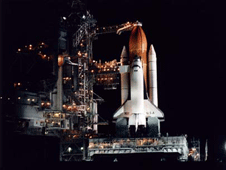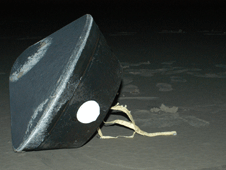Exploration
Text Size
This Month in Exploration - January
01.09.09
 The Russian Luna 1 spacecraft. Credit: NASA
100 Years Ago
The Russian Luna 1 spacecraft. Credit: NASA
100 Years AgoJanuary 1909: Before this year, no two airplanes of the same design existed in the United States.
80 Years Ago
January 7, 1929: Maj. Carl Spaatz, Capt. Ira C. Eaker, and Lt. Elwood Quesada set an unofficial endurance record for refueled airplane flight over Los Angeles Airport in the "Question Mark," Fokker C2-3 Wright 220. The flight, which began on Jan. 1, lasted 150 hours, 40 minutes, 15 seconds.
75 Years Ago
January 10-11, 1934: Six Navy Consolidated P2Y-1's flew 2,399 miles nonstop from San Francisco to Pearl Harbor, Hawaii, in 24 hours and 56 minutes, setting new records for speed and distance while formation flying.
60 Years Ago
January 7, 1949: Capt. Charles E. Yeager set a new climbing speed record of 13,000 feet per minute in the Bell X-1 at Muroc, climbing 23,000 feet after launching from the bomb bay of a larger plane. Yeager named the rocket-engine plane "Glamorous Glennis" in tribute to his wife.
50 Years Ago
January 2, 1959: The USSR launched the Luna 1 →, which became the first manmade object to escape Earth's atmosphere and orbit the sun.
 Space Shuttle Columbia on pad before launch. Credit: NASA
45 Years Ago
Space Shuttle Columbia on pad before launch. Credit: NASA
45 Years AgoJanuary 29, 1964: NASA sent a record 19 tons into orbit during a test flight of its largest launch vehicle, the Saturn SA-5.
40 Years Ago
January 5, 1969: The USSR launched the Venus V unmanned probe on a four-month journey to Venus. The probe carried scientific instruments to study the planet's atmosphere.
January 9, 1969: The United States Air Force released a three-volume Scientific Study of Unidentified Flying Objects. The report concluded, "Nothing has come from the study of UFO's in the past 21 years that has added to scientific knowledge. . . . Further extensive study of UFO's probably cannot be justified in the expectation that science will be advanced thereby."
30 Years Ago
January 22, 1979: Neptune became the outermost planet when Pluto edged inside its orbit and remained there until March 1999.
January 25, 1979: NASA announced the official names of the first four space shuttle orbiters that would operate in space. Each name honors a U.S. explorer ship. Columbia was named after Captain Robert Gray's sloop. The Challenger was named for a ship that gathered 50 volumes of data on Earth's oceans in the 1970s. Discovery was named for the ship looking for a northwest passage from the Atlantic Ocean to the Pacific Ocean by exploring Hudson Bay in 1610. Atlantis was the first US.-operated vessel designed for ocean research.
25 Years Ago
January 25, 1984: As part of his State of the Union Address before Congress, President Ronald Reagan announced plans to build a space station within a decade.
|
TO SUBSCRIBE: Get NASA's This Month in Exploration in your inbox every month. Send us an e-mail today. > Read More |
January 3, 1989: In a joint U.S.-European effort, a NASA ER-2 high-altitude aircraft flew the first of a dozen scientific missions over the Arctic Circle to document the depletion of the atmospheric ozone layer around the North Pole. The depletion was caused by chlorofluorocarbons and other manmade chemicals.
January 11, 1989: NASA issued a request for proposals to design and build a radar to find debris as small as one centimeter in diameter orbiting between 180 and 360 miles above Earth. Scientists planned to use the data to design the Space Station Freedom, which eventually evolved into the International Space Station.
15 Years Ago
January 8, 1994: Russia launched the passenger craft Soyuz TM-18 from Baikonur Cosmodrome. It carried three cosmonauts -- Viktor Afanasyev, Yuri Usachev and Valery Polyakov -- to the MIR station.
January 25, 1994: The United States launched the moon orbiter Clementine. The mission tested sensors and spacecraft components under extended exposure to the space environment and made scientific observations of the moon.
10 Years Ago
January 3, 1999: The United Stated launched the Mars Polar Lander from Cape Canaveral at 20:21 UT using a Delta 2 rocket. The lander, designed to search for near-surface ice on Mars, was lost during its attempted landing on Mars on Dec. 3, 1999.
 Stardust sample return capsule. Credit: NASA
Five Years Ago
Stardust sample return capsule. Credit: NASA
Five Years AgoJanuary 2, 2004: NASA's Stardust spacecraft successfully navigated through the nebulous cloud of ice and dust surrounding the nucleus of comet Wild 2. It was the first sample return mission to a comet, and the flyby yielded the most detailed images of a comet ever taken.
January 14, 2004: In a speech at NASA Headquarters in Washington, D.C, President George W. Bush announced the new Vision for Space Exploration. Among its goals and objectives, the Vision addressed a human return to the moon by 2020 in preparation for human exploration of Mars and other destinations.
Present Day
January 15, 2009: NASA will launch the Orbiting Carbon Observatory via the Orbital Sciences Taurus Rocket at Vandenberg Air Force Base from launch Pad SLC-576-E. The orbiting Carbon Observatory is a new Earth Orbiting mission sponsored by NASA's Earth System Science pathfinder program. It will collect precise measurements of carbon dioxide from Earth's atmosphere.
Lee A. Jackson (Analex Corporation)
See Past Issues:
> This Month in Exploration Main